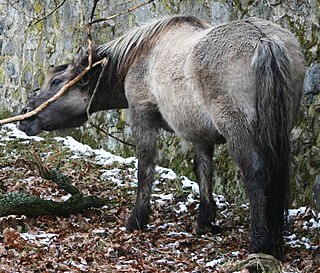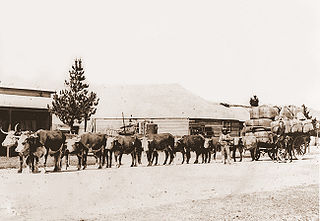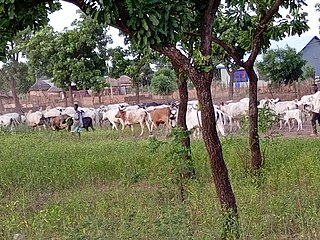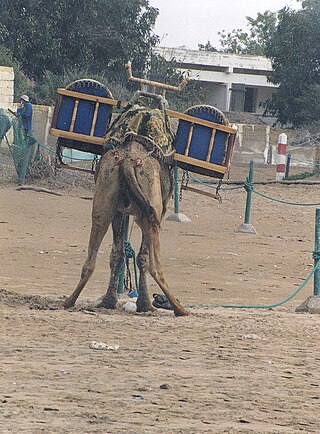Related Research Articles

A camel is an even-toed ungulate in the genus Camelus that bears distinctive fatty deposits known as "humps" on its back. Camels have long been domesticated and, as livestock, they provide food and textiles. Camels are working animals especially suited to their desert habitat and are a vital means of transport for passengers and cargo. There are three surviving species of camel. The one-humped dromedary makes up 94% of the world's camel population, and the two-humped Bactrian camel makes up 6%. The wild Bactrian camel is a distinct species that is not ancestral to the domestic Bactrian camel, and is now critically endangered, with fewer than 1,000 individuals.

Mehrgarh is a Neolithic archaeological site situated on the Kacchi Plain of Balochistan in modern-day Pakistan. It is located near the Bolan Pass, to the west of the Indus River and between the modern-day Pakistani cities of Quetta, Kalat and Sibi. The site was discovered in 1974 by the French Archaeological Mission led by the French archaeologists Jean-François Jarrige and Catherine Jarrige. Mehrgarh was excavated continuously between 1974 and 1986, and again from 1997 to 2000. Archaeological material has been found in six mounds, and about 32,000 artifacts have been collected from the site. The earliest settlement at Mehrgarh, located in the northeast corner of the 495-acre (2.00 km2) site, was a small farming village dated between 7000 BCE and 5500 BCE.
The 3rd millennium BC spanned the years 3000 to 2001 BC. This period of time corresponds to the Early to Middle Bronze Age, characterized by the early empires in the Ancient Near East. In Ancient Egypt, the Early Dynastic Period is followed by the Old Kingdom. In Mesopotamia, the Early Dynastic Period is followed by the Akkadian Empire. In what is now Northwest India and Pakistan, the Indus Valley civilization developed a state society.

How and when horses became domesticated has been disputed. Although horses appeared in Paleolithic cave art as early as 30,000 BC, these were wild horses and were probably hunted for meat. The clearest evidence of early use of the horse as a means of transport is from chariot burials dated c. 2000 BC. However, an increasing amount of evidence began to support the hypothesis that horses were domesticated in the Eurasian Steppes in approximately 3500 BC. Discoveries in the context of the Botai culture had suggested that Botai settlements in the Akmola Province of Kazakhstan are the location of the earliest domestication of the horse. Warmouth et al. (2012) pointed to horses having been domesticated around 3000 BC in what is now Ukraine and Western Kazakhstan.
Human history is the record of humankind from prehistory to the present. Modern humans evolved in Africa around 300,000 years ago and initially lived as hunter-gatherers. They migrated out of Africa during the Last Ice Age and had populated most of the Earth by the end of the Ice Age 12,000 years ago. Soon afterward, the Neolithic Revolution in West Asia brought the first systematic husbandry of plants and animals, and saw many humans transition from a nomadic life to a sedentary existence as farmers in permanent settlements. The growing complexity of human societies necessitated systems of accounting and writing.

The Neolithic Revolution, also known as the First Agricultural Revolution, was the wide-scale transition of many human cultures during the Neolithic period in Afro-Eurasia from a lifestyle of hunting and gathering to one of agriculture and settlement, making an increasingly large population possible. These settled communities permitted humans to observe and experiment with plants, learning how they grew and developed. This new knowledge led to the domestication of plants into crops.

This timeline tries to compile dates of important historical events that happened in or that led to the rise of the Middle East. The Middle East is the territory that comprises today's Egypt, the Persian Gulf states, Iran, Iraq, Israel and Palestine, Cyprus, Jordan, Lebanon, Oman, Saudi Arabia, Syria, Turkey, United Arab Emirates, and Yemen. The Middle East, with its particular characteristics, was not to emerge until the late second millennium AD. To refer to a concept similar to that of today's Middle East but earlier in time, the term ancient Near East is used.

Richard Nelson Frye was an American scholar of Iranian and Central Asian studies, and Aga Khan Professor Emeritus of Iranian Studies at Harvard University. His professional areas of interest were Iranian philology and the history of Iran and Central Asia before 1000 CE.

Efraim Karsh is an Israeli and British historian who is the founding director and emeritus professor of Middle East and Mediterranean Studies at King's College London. Since 2013, he has served as professor of political studies at Bar-Ilan University. He is also a principal research fellow and former director of the Middle East Forum, a Philadelphia-based think tank. He is a vocal critic of the New Historians, a group of Israeli scholars who have questioned the traditional Israeli narrative of the Arab–Israeli conflict.

A working animal is an animal, usually domesticated, that is kept by humans and trained to perform tasks instead of being slaughtered to harvest animal products. Some are used for their physical strength or for transportation, while others are service animals trained to execute certain specialized tasks. They may also be used for milking or herding. Some, at the end of their working lives, may also be used for meat or leather.
The Islamization of Iran was the spread of Islam in formerly Sassanid Iran as a result of the Muslim conquest of the empire in 633–654. It was a long process by which Islam, though initially rejected, eventually spread among the population on the Iranian Plateau. Iranian peoples have maintained certain pre-Islamic traditions, including their language and culture, and adapted them with Islamic codes. These two customs and traditions merged as the "Iranian Islamic" identity.

Nomadic pastoralism is a form of pastoralism in which livestock are herded in order to seek for fresh pastures on which to graze. True nomads follow an irregular pattern of movement, in contrast with transhumance, where seasonal pastures are fixed. However, this distinction is often not observed and the term 'nomad' used for both—and in historical cases the regularity of movements is often unknown in any case. The herded livestock include cattle, water buffalo, yaks, llamas, sheep, goats, reindeer, horses, donkeys or camels, or mixtures of species. Nomadic pastoralism is commonly practised in regions with little arable land, typically in the developing world, especially in the steppe lands north of the agricultural zone of Eurasia. Pastoralists often trade with sedentary agrarians, exchanging meat for grains, however have been known to raid.

Jahan Salehi is an Iranian-American entrepreneur and progressive activist, He has worked for Agence Global, a left-leaning news and commentary syndicate, and as Managing Director of the Los Angeles Times Syndicate's European operations.
Roy Parviz Mottahedeh was an American historian who was Gurney Professor of History, Emeritus at Harvard University, where he taught courses on the pre-modern social and intellectual history of the Islamic Middle East and was an expert on Iranian culture. Mottahedeh served as the director of Harvard's Center for Middle Eastern Studies from 1987 to 1990, and as the inaugural director of the Prince Alwaleed Bin Talal Islamic Studies Program at Harvard University from 2005 to 2011. He was a follower of the Baha'i faith.
According to Islam, animals are conscious of God. According to the Quran, they praise Him, even if this praise is not expressed in human language. Baiting animals for entertainment or gambling is prohibited. It is forbidden to kill any animal except for food or to prevent it from harming people.

Richard Foltz is a Canadian historian who specializes in the history of Iranian civilization — sometimes referred to as "Greater Iran". He has also been active in the areas of environmental ethics and animal rights.

Camel urine is a liquid by-product of metabolism in a camel's anatomy. Urine from camels has been used in prophetic medicine for centuries, being a part of ancient Bedouin practices and also Muslim tradition. According to the World Health Organization, the use of camel urine as a medicine lacks scientific evidence. After the spread of MERS-CoV infections, the WHO urged people to refrain from drinking "raw camel milk or camel urine or eating meat that has not been properly cooked".
Shireen Tahmaaseb Hunter is an independent scholar. Until 2019, she was a Research Professor at the Center for Muslim-Christian Understanding (ACMCU) at Georgetown University in Washington, D.C., with which she had been associated since 2005, as Visiting Fellow and then Visiting Professor. She became an honorary fellow of ACMCU in September 2019.
Yaʽfūr was a donkey used as a mount by the Islamic prophet Muhammad, who was said to have often ridden it without harness. There are many tales of this donkey but the most common would be that the donkey is recorded to have been a gift from the Byzantine governor of Egypt some time between 628 and 632 AD. According to a Shi'ite Islamic tradition, it had the power of speech and told Muhammad that it was the last of a line of donkeys ridden by prophets and was a descendant of the donkey ridden by Jesus in his triumphal entry into Jerusalem, which was also called Yaʽfūr. The tradition holds that Yaʽfūr committed suicide in despair after Muhammad died by throwing itself into a well, though these accounts are held to be unreliable in hadith studies. In the centuries after Muhammad's death, the donkey's name and symbolism was repeatedly adopted by Islamic religious figures and rulers.

The wild Bactrian camel is an endangered species of camel endemic to Northwest China and southwestern Mongolia. It is closely related but not ancestral to the domestic Bactrian camel. Genetic studies have established it as a separate species which diverged from the Bactrian camel about 0.7–1.1 million years ago.
References
- ↑ "Bulliet, Richard". Department of History - Columbia University. 2016-11-09. Retrieved 2024-05-15.
- ↑ Bulliet, Richard W. (1975). The camel and the wheel. Internet Archive. Cambridge, Mass. : Harvard University Press. ISBN 978-0-674-09130-6.
- ↑ "Deep Historical Perspectives: Hunters, Herders, and Hamburgers, a Virginia Tech student review". 3 February 2013. Retrieved December 21, 2019.
- ↑ "Bulliet Juggles Controversy, Comic Books [on Richard Bulliet]". Middle East Forum. 2008-11-14. Retrieved 2024-09-12.
- ↑ "Time to End US Fear of the Muslim Brotherhood". The Guardian. February 3, 2011. Retrieved December 21, 2019.
- ↑ "With or Without Mubarak, the Generals Flourish". The New York Times International Edition . February 12, 2011.
- ↑ SZ, 4.6.2004, "Whose Theocracy?"
- ↑ Bulliet, Richard. "PAGES FROM A MEMOIR—WHAT I'VE PUBLISHED".
{{cite journal}}: Cite journal requires|journal=(help) - ↑ "In the Eye of the Storm". Columbia Magazine. Retrieved 2024-09-12.
- ↑ "Bulliet Juggles Controversy, Comic Books [on Richard Bulliet]". Middle East Forum. 2008-11-14. Retrieved 2024-09-12.
- 1 2 "Columbia University Faculty CV" . Retrieved December 21, 2019.